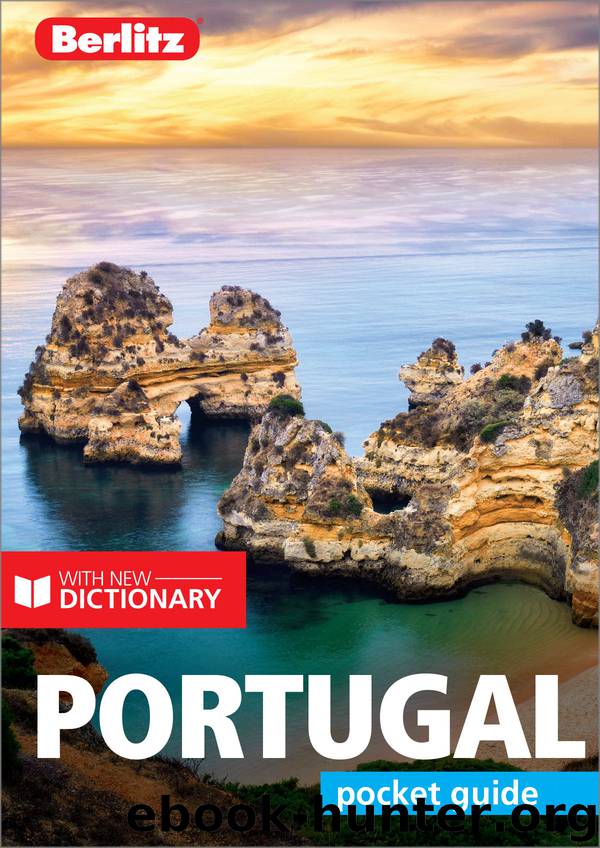Berlitz Pocket Guide Portugal by Berlitz Publishing

Author:Berlitz Publishing
Language: eng
Format: epub
Tags: Travel, Portugal
Publisher: Apa Publications
Published: 2018-09-05T16:00:00+00:00
São Lourenço dos Matos
iStock
Loulé, north of Almancil, is a prosperous town known for its leather, lace and copper goods. People come from far and wide to shop at the colourful, bustling market. Just below the permanent market halls on the main Praça da República, you’ll find a well-preserved section of the medieval castle walls (which were much damaged by the 1755 earthquake). Also worth visiting are the Igreja Matriz (São Clemente), a 13th-century Gothic church with 18th-century azulejo tiles; the Convento da Graça, with a superb Manueline portal; and Ermida de Nossa Senhora da Conceição, a small church prized for its baroque altar and tiles. In the streets below the castle walls, you may hear the sound of craftsmen beating copper into utensils that you can buy directly from them.
São Brás de Alportel is another market town and site of one of three comfortable pousadas (inns) along the Algarve, in the midst of rolling orchards of fig, olive and orange trees. The Museu do Traje (Museum of Costumes; Mon–Fri 10am–1pm and 2–5pm, Sat–Sun 2–5pm; www.museu-sbras.com) has exhibits of local dress in a large, old house 90m (100yds) off the main square.
On the road to Faro, the Palácio de Estói fi [map] is a most curious find. The attractive 18th-century rococo palace once belonged to the Dukes of Estói. It’s been converted into a luxurious pousada. Its gardens are an intriguing sight with balustrade terraces and staircases with splendid bursts of bougainvillea, busts of historic characters impaled on the parapets, brightly coloured wall tiles and formal gardens.
The Vila Romana de Milreu (Tue–Sun, May–Sept 9.30am–1pm and 2–6.30pm, Oct–Apr 9.30am–1pm and 2–5.30pm) is 1.5km (1 mile) down the road from Estói towards Faro. A small sign on the side of the road reads ‘Ruinas de Milreu’ (ruins of Milreu). The tall, semi-circular ruin of a Roman tower is thought to have been a temple to pagan water gods at one time; however, by the 5th century it had clearly been converted to a church. The Roman mosaics, though small, are impressive.
Loulé Carnival
Download
This site does not store any files on its server. We only index and link to content provided by other sites. Please contact the content providers to delete copyright contents if any and email us, we'll remove relevant links or contents immediately.
Spell It Out by David Crystal(36045)
Underground: A Human History of the Worlds Beneath Our Feet by Will Hunt(12027)
A Year in the Merde by Stephen Clarke(5328)
Venice by Jan Morris(2527)
Claridge's: The Cookbook by Nail Martyn & Erickson Meredith(2359)
My Paris Kitchen: Recipes and Stories by Lebovitz David(2259)
A TIME OF GIFTS by Patrick Leigh Fermor(2156)
The Plantagenets by Dan Jones(2042)
Welcome to the Goddamn Ice Cube by Blair Braverman(1994)
The Finnish Way by Katja Pantzar(1940)
Top 10 Prague (EYEWITNESS TOP 10 TRAVEL GUIDES) by DK(1934)
From Russia with Lunch by David Smiedt(1933)
Bang Poland: How To Make Love With Polish Girls In Poland by Roosh V(1925)
The Isle of Mull by Terry Marsh(1899)
A TIME TO KEEP SILENCE by Patrick Leigh Fermor(1865)
Rick Steves London 2018 by Rick Steves & Gene Openshaw(1823)
Insight Guides Experience Tokyo by Insight Guides(1816)
A Taste of Paris by David Downie(1813)
Merde in Europe by Stephen Clarke(1726)
